My arrival in Mumbai (then Bombay)
In retrospect, I think Mumbai was destined to become my ‘Karam Bhoomi’. Immediately after our exodus from ‘Janam Bhoomi’ Kashmir, I had visited Mumbai for a brief period in 1990. Four years later I was back, having spent the intervening years nearer home, in Jammu. This time I had come bag and baggage, with family, for good.
In retrospect, I think Mumbai was destined to become my ‘Karam Bhoomi’. Immediately after our exodus from ‘Janam Bhoomi’ Kashmir.
A natural inclination to stay close to my biradari led me to Kashyap Bhawan, a cultural center set up by KPA of whom I had heard before I arrived in the city.
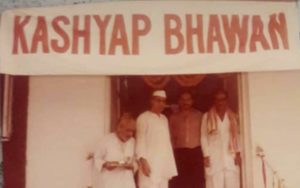
This was in early 1995 and the occasion was Navreh. As expected, I met several members of my biradari along with their families. I had the pleasure of meeting community icons like Late Shri M.L.Mattoo, Late Shri J.L.Manwati, Late Shri Onkar Aima, Late Shri N.N.Wanchoo, Late Shri N.N.Pandit, Late Shri Ramji Sabni, Late Shri P.N.Taku, Late Smt. Shanta Kapoor, Capt. A.K.Misri, Shri P.N.Wali and Smt. Neena Kher among others.

I have always loved my mother tongue and back home in Srinagar, I had tried my hand at writing poems in Kashmiri. I had developed great interest in literature and a passion for our language, which became more intense post our exile from our Motherland. I introduced myself to Shri Wali Saab, who was editor of the community magazine Milchar, and handed him some of my writings, poems in Hindi & Kashmiri for his perusal.
After going through the pages, Wali Saab readily accepted my request. That was a great day for me. My poems used to be published in Urdu newspapers like Aftab, Srinagar Times and Shahmir of Srinagar, during the 80s. However, getting published in the community magazine was a new high, a craving that got fulfilled. Later of course, my writings were also published in Koshur Samachar of Delhi and other community magazines.
“My poems used to be published in Urdu newspapers like Aftab, Srinagar Times and Shahmir of Srinagar, during the 80s”
I had already become life member of KPA, in December 1994, at the insistence of Late Shri N.N.Wanchoo.
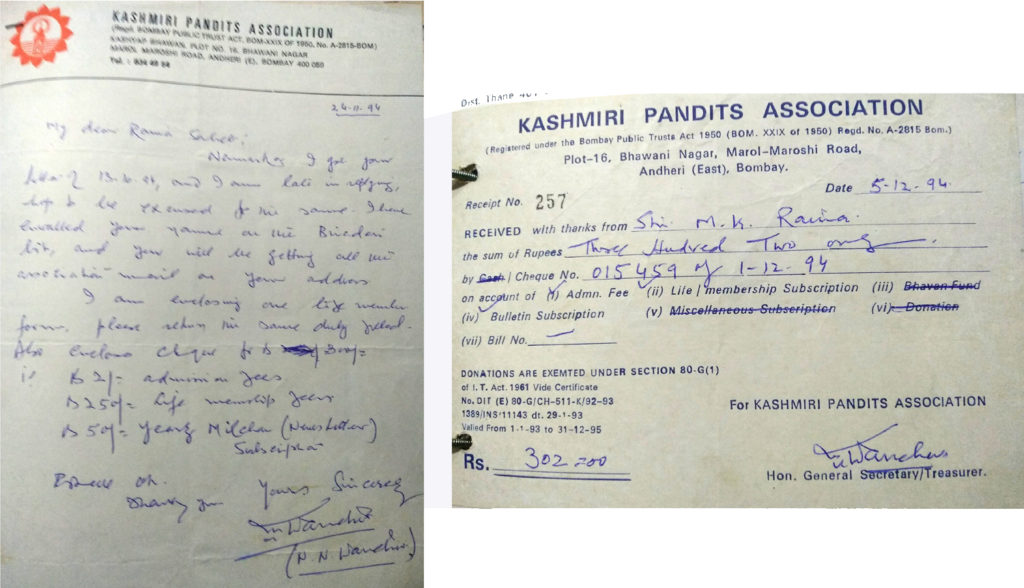
In recognition of my zeal for community social work, I was elected to the Board of Trustees, and later in 1996, as General Secretary, during Shri P.N.Wali’s tenure as President.
During the years 1996 to 2007, I volunteered to take up three responsibilities, solely and exclusively:
- Milchar.
- Life Membership.
- Biradari Directory
Milchar:
Milchar was a 12 Page Compendium in 1996, hardly having any scope for big write-ups. This was at the most a community news letter that Wali Saab tried to give some shape to as a magazine, with the limited resources at his disposal.
To go further back into history of Milchar, it was said to have been created in the late fifties, a few years after the Kashmiri Pandits’ Association was formed, as a cyclostyled 8 odd pages news letter. The content was mainly biradari news, like change of addresses, births, deaths, matrimonial, reports about newcomers etc.
In his interview with Chand Bhat in 2016, the editor of Milchar, Shri P.N.Wali states thus: “It (Milchar) was issued from the house of Shri M.L.Kaul at Parsi Panchayat Road. The celebrated film maker Shri Aroon Kaul was one of the founders. It was then issued as a cyclostyled sheet, carried forward with the efforts of people like Shri M.L.Kasid. Keeping it going was an uphill task, and it was the dedicated perseverance of Shri Wanchoo that kept it alive. And it was Shri Wanchoo’s spirit that drew me to continue being with Milchar.”
The oldest Milchar I have in my library is that of Jan-March 1990, edited by Mrs. Basanti Raina. This is a 24 page issue in the shape of a magazine with cover in colour:
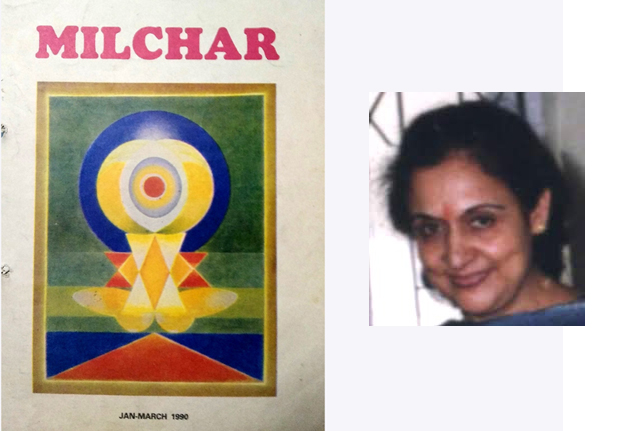
Mrs. Basanti Raina wrote in the Editorial of Jan-March 1990: “The latest issue of Milchar makes a distinct departure from past practices, reflecting of changing times where the presentation is entirely different. For giving the magazine a different face lift, mention must be made of our new President Mr. R.C.Sheopuri, whose overwhelming and selfless contribution towards the magazine made it possible to present Milchar in a different form. It carries more pages and has a printed cover …….”
This issue of Milchar carried a rare painting on its cover by Late Shree Ghulam Rasool Santosh, a renowned artist of Kashmir, Sahitya Academy Awardee and Padam Shree.

There is also a write up on The Music of Kashmir by Late Shri Mohan Lal Aima, a rare piece indeed.
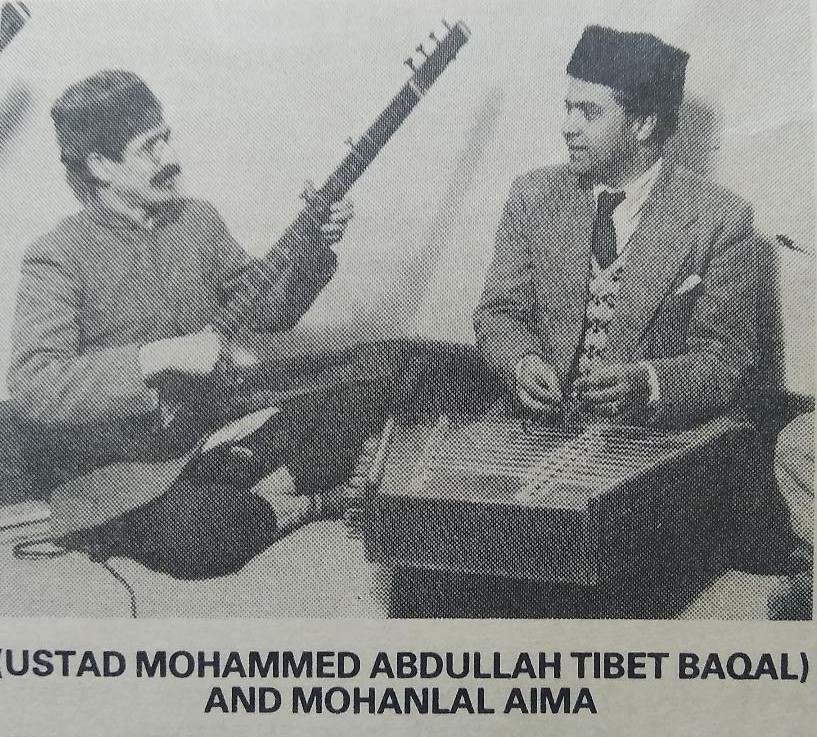
April-June 1990 issue of Milchar, second from the editor Mrs. Basanti Raina also needs a special mention. Photo carried on its cover is historic, Mumbai KPs protesting at Kala Ghoda immediately after the exodus of Kashmiri Pandits from Kashmir in 1990.
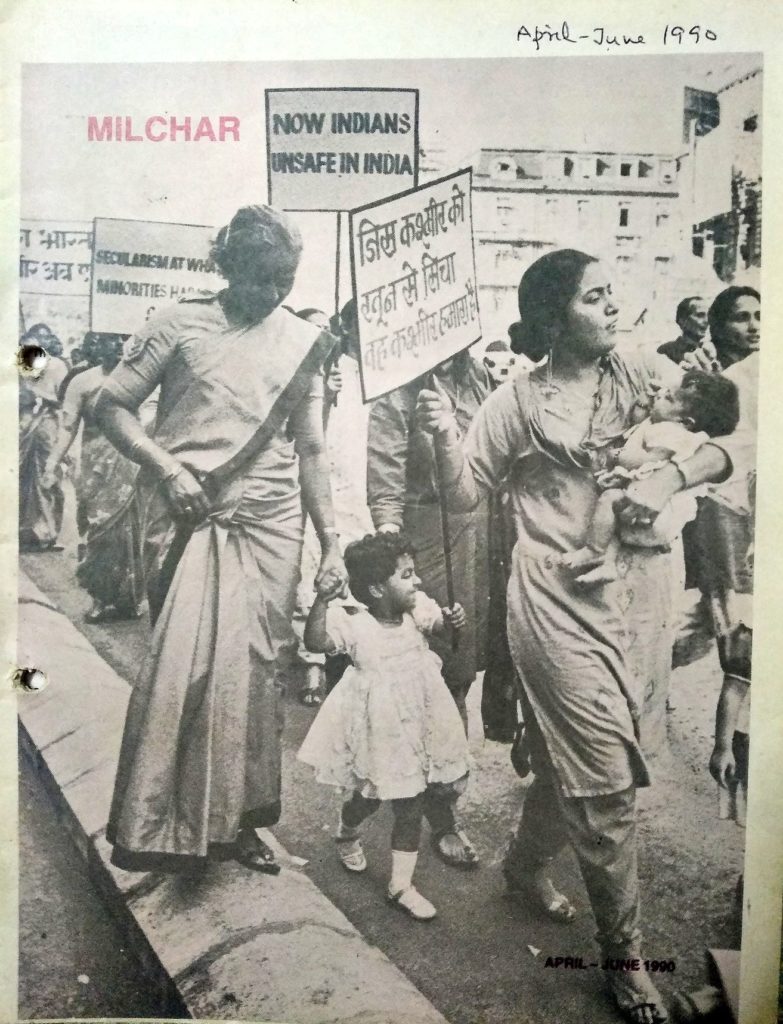
Shri Sheopuri is said to have got the journal printed at Indian Express free of cost during his tenure as President of the KPA.
In the Milchar July-September 1990 issue (44 pages, edited by Mrs. Basanti Raina), I find a write-up from Shri T.N.Dhar Kundan, the present Consulting Editor of Milchar, titled Origin and Meaning of Saraswats – an informative and valuable piece for Kashmiri Pandits.
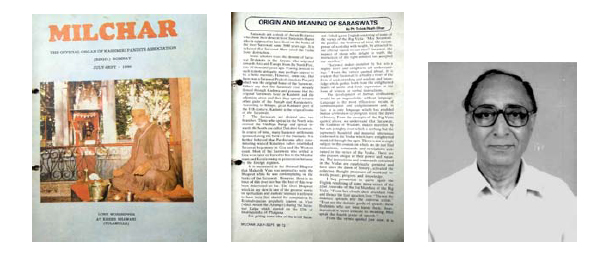

The write-up also established the fact that the community mouthpiece did carry write ups from established writers on the topics related to our identity, culture and language at that time. However the trend did not continue for long as is evident from the editorial by Shri P.N.Wali in June 1992 issue (30 pages)
“Editor of a community magazine like Milchar has often an unenviable task to do. Budgets are short, content is often slow coming in, presses do not think much of him as he is a casual customer. Basanti Raina and Nirja Mattoo must have suffered this predicament together with the ever supporting Sheopuri Ji as editors of this magazine, before I took over. I am thankful to some of my friends who have sent me material for the present issue. I would like more contributions.”
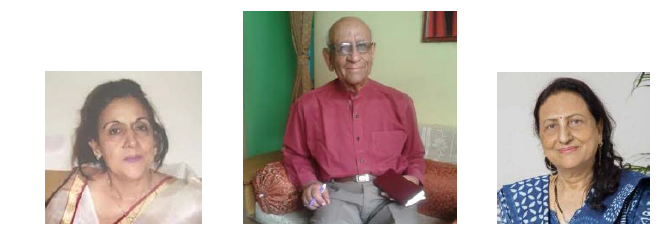
It may be mentioned that a column titled ‘Reflections’ by Krakal used to be a favourite page written by Wali Sahib since a couple of years reflecting upon the current affairs and news related to KPs and their exodus. The column continued till Wali Sahib was editor and beyond.
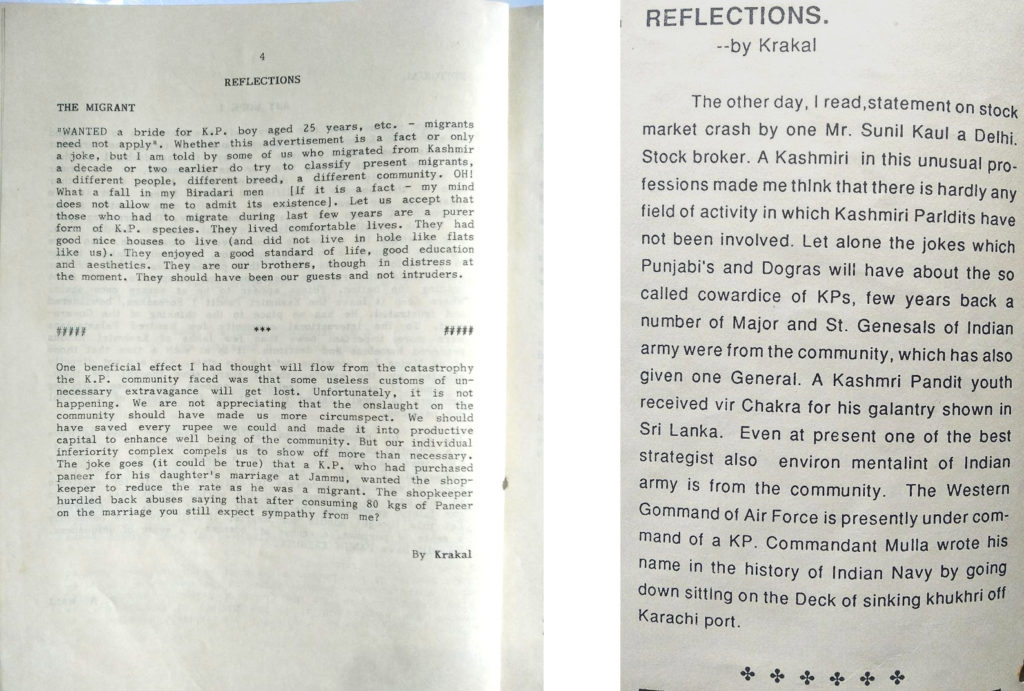
February 1993 issue was 22 pages but smaller in size, half A4. Edited by Shri P.N.Wali, this issue contained news about itself in the following words: “The last issue of Milchar had more than its share of printing errors. We regret the inconvenience caused to our readers because of this. We will make effort to improve. Thanking you for your indulgence.”
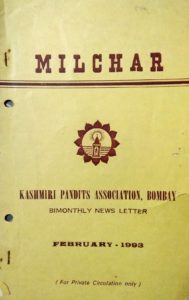
August 1993 Milchar (22 Pages) carried the Annual Report for the year 1992-93 which included a note referring to the report itself:

“We have not at all come up to the expectations of our members. Initially, publication came out regularly but then we lost track. We did debate regularly but somehow a proper solution was not found. There are two schools of thought. One says that we must continue with the publication in spite of limitation of time, correct manpower etc. The second advocates that Bombay Chapter should be part of Koshur Samachar, Delhi Samiti Publication, who are indeed doing a good job. Let us debate during AGM.”
It is evident that our language and cultural heritage had always been an issue which the editors of the community magazines all over India took up seriously and carried in the pages of their publications. Milchar and its editors do not seem to have lagged behind on this account. In the July-September 1994 issue of Milchar (an 8 page compendium), Shri P.N.Wali writes in its Editorial ‘Kashmiri as our language’:
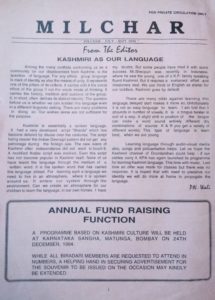
“….. None of us have learnt the (Kashmiri) language through the medium of a written word. It is the spoken word that has carried this language ahead. For learning such a language we need to live in an atmosphere where it is spoken around us. It enters our system through the environment. Can we create an atmosphere for our children to learn the language in our homes? I have my doubts……..”
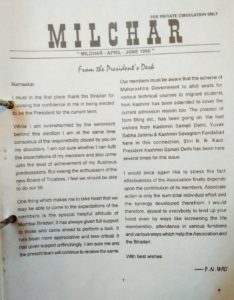
Milchar April-June 1996, a 12-page News Letter came out when Wali Saab was President of the Association as well as the Editor of Milchar. I was General Secretary of the KPA and assisted Wali Saab in editing work also. Due to the sad demise of Shri N.N.Wanchoo, I had to also take over as Publisher of the magazine. Till that date Wanchoo Sahib used to do everything related to subscription and circulation of Milchar himself. He used to send hand written letters to people asking them to pay subscription for Milchar and become life members of the Association. I have a series of his hand-written letters kept safe till date.

Karamyogi Shri N.N.Wanchoo Sahib
Wanchoo Saab was an institution in himself. I still believe, nobody can ever replace this Karmayogi as far as discharge of one’s duties to a social cause is concerned. In fact, he was the soul of the Kashmiri Pandits’ Association. As far as Milchar was concerned, he always treated it as his dearest baby. He used to write addresses of the subscribers on the envelopes with his own hand and send the copies to post office in bunches (sometimes carried it himself) to post. It would take him between a week and a fortnight to complete posting of all the copies. I once asked him if he was not tired of doing all that laborious work, at that age. His answer was “If you have the tsuk (acute desire) in your heart, you don’t get tired.” I still remember the occasion and the way Wanchoo Sahib said it to me. Wanchoo Saab left for his heavenly abode in July 1996. We often see departed people referred to as Karamyogis in the obituaries printed in newspapers and community magazines, but for me, Wanchoo Sahib was the real Karmyogi and the only one of his kind. His departure was a great loss to the Mumbai biradari.
“Wanchoo Sahib was the real Karmyogi and the only one of his kind. His departure was a great loss to the Mumbai biradari.
From 1992 till June 1999, Milchar continued to be a News Letter of the Kashmiri Pandits’ Association, Mumbai with a Bhajan or a poem or a small write up here and there. It was not a literary magazine. July-September 1996 issue was skipped. From Oct-Dec 1996, a page of Milchar was dedicated to Lalla Ded Educational and Welfare Trust which had come into being some time back, to carry its news and informative material.
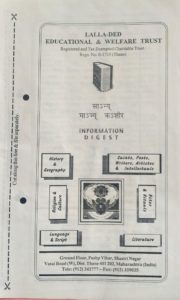
From January-April 2000 issue, we started publishing articles and poems from local contributors. It may be recalled that the issues right from January 1994 till September 2001 were ordinary cover printed in black.
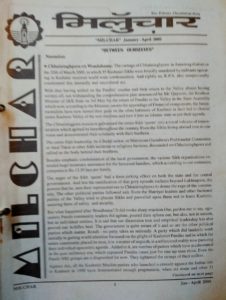
In the year 2001, I was designated Milchar’s Coordinating Editor and I took over responsibility with regard to content of the magazine. I was already looking after the subscription and distribution part of the magazine after the demise of Shri Wanchoo Saab. A 32-40 page Milchar in magazine form (but without a cover in color), began to be published once in a quarter till end of 2003, when it became a bi-monthly (once in two months) magazine. It was published without any interruption till August 2007, when I had to quit because of my official assignments. It had become a regular magazine now with literary contributions from reputed KP writers.
“I took over responsibility with regard to content of the magazine. I was already looking after the subscription and distribution part of the magazine after the demise of Shri Wanchoo Saab.
KPA news remained uncovered for the period between September 2007 and December 2010. Milchar could not be published since nobody took the responsibility to edit it. Finally publication was resumed from the January-February 2011 issue when I could not say ‘No’ to Shri Rajen Kaul’s and Shri S.P.Kachru’s request of editing it again.
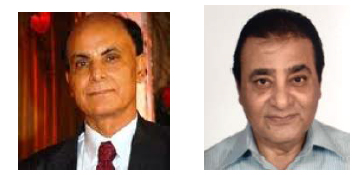
The 52 page Milchar now came with a coloured cover and a refurbished get up, thanks to the management for granting more funds. I edited it till Nov-Dec 2012 issue after which Shri Chand Bhat took over its responsibilities. Presently Shri Chand Raina is the editor of the magazine.
Apart from editing and publishing Milchar from 1996 till 2007, I also undertook to exhort people to subscribe to the magazine and maintained the subscription and mailing data at my personal level. Every address label, which was generated at my private office, gave subscription renewal dates to enable readers to renew in time. Data used to be shared with the KPA office on regular basis.
In order to improve the quality of our magazine and its content, I, as its editor, not only maintained personal relations with our celebrated writers in Delhi, Jammu, Kolkata, Bangaluru and other places, but also made it a point to be in constant touch with them, by calling on the phone or meeting them in person whenever possible, at their homes.
This brought me closer to community luminaries – reputed writers like Late Shri Arjun Dev Majboor, Late Shri M.L.Kemmu, Shri T.N.Dhar Kundan, Late Prof. Omkar Kaul, Shri Roop K. Bhat, Dr. B.K.Moza, Dr. K.L.Chowdhury, Smt. Bimla Raina, Prof. R.N.Bhat (BHU), Late Shri Piyaray Raina Saddhak, Shri S.K.Raina, Late Shri P.N.Kaul Sayil, Shri B.K.Dass, Shri Anil Nakhasi (Cartoonist), Shri B.N.Sharga (Lucknow), Shri Bal Krishen Sanyasi, Shri Brij Hali, Shri B.N.Betab, Dr. C.L.Raina (Miami), Shri C.L.Gadoo, Shri Dilip Langoo, Late Shri H.N.Kaul Rind (Baroda), Shri J.L.Bhat, Shri Kamal Hak, Shri M.L.Kanwal, Shri M.K.Kaw, Prof. M.K.Mujoo, Shri M.L.Koul Naaz, Dr. Phool Chandra, Shri P.N.Shad, Shri Ravinder Ravi, Shri R.K.Mattoo, Prof R.L.Shant, Dr. Romesh Raina, Dr. Roshan Saraf, Shri Virender Qazi, Late Shri Tribhuwan Bhan, Chander M. Bhat, Jaya Sibu, R.L.Jowhar etc. Their writings were a regular feature in Milchar. I continue to be in touch with all those who are still living, though I left editorship of Milchar decades ago.

Life Membership
When I joined KPA and became its life member in December 1994, it had 219 living Life Members registered from June 1984 (when KPA was re-registered with the Charity Commissioner after amalgamation with Kashmiri Pandits’ Mandal Trust) till November 1994. A typed document kept on record which I perused on taking over as General Secretary of the Association in early 1996 showed names of the Life Members without their addresses or any other identification. It was this document that was referred to during the 1996 election, to confirm bona fide voters. Last entries were those of the 13 people (including me) who had become life members in the last quarter of 1994 and were listed in the Milchar of Oct-Dec 1994. Only one life member was added in the year 1995. I had to count the numbers to compute the total number of life members and exclude those who had passed away but were still there in the list. Number of living life members was computed at 220. That was till end of 1995.
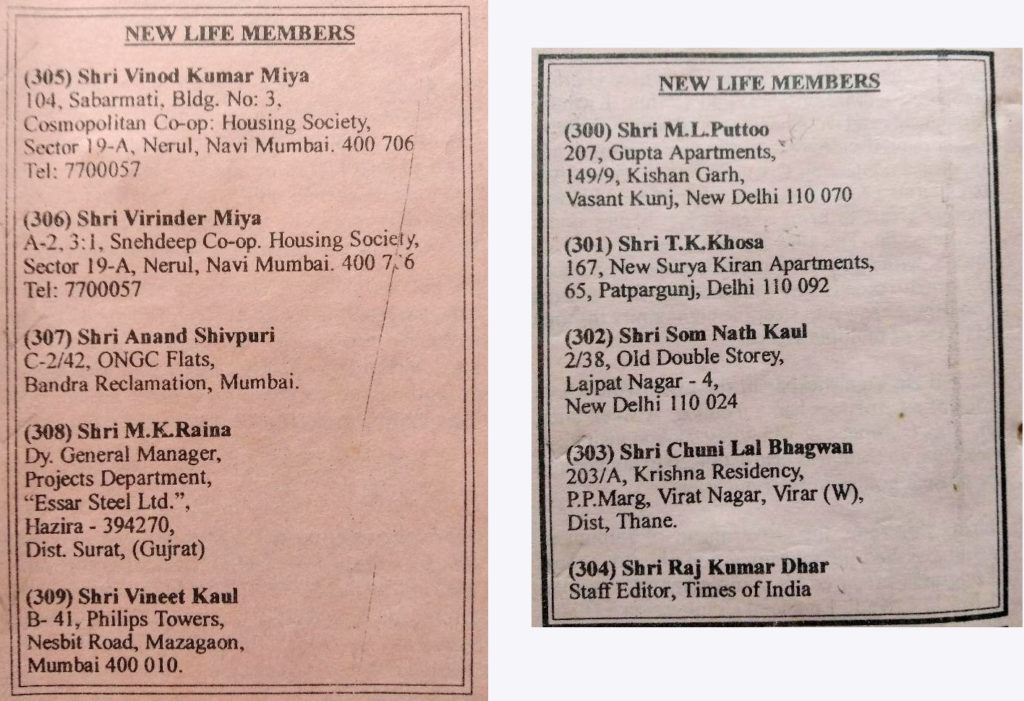
“In order to make a register of Life Members, we allotted Life Membership numbers to the living members. Those listed in the issues of Milchar till June 1997 after having paid their life membership fee were also allotted numbers. From July 1997 onwards, life membership number came printed along with the names of new members in Milchar.
I used to call people almost on daily basis, asking them to enroll as life members of the Association and also to pay subscription for Milchar. During our drive to acquaint people with the formation of Lalla Ded Educational Trust when we used to go from door to door for donations, I would never forget to carry KPA life membership forms and Milchar subscription forms with me. Many times I used to get the answer ‘We already get Milchar, so we must be life members already.’ It may be recalled that during those days, Milchar used to be sent to every address available whether one was a real subscriber or a life member or not, simply to let people know about the activities of KPA Mumbai.
During the years from 2000 to 2007, I volunteered to issue laminated Life Membership Cards with photos and President’s signatures to every new life member (and old members who asked for it) free of cost. About 180 cards were issued. These cards are still available with some people including me. I also made dual lists of the life members. One list gave the names and addresses serially according to life membership numbers. The other would give names of the members in alphabetical order with their life membership numbers. This continued till 2007. Both updated lists were kept at the KPA office in hard as well as soft copies. The alphabetical list enabled anybody to see whether she or he was a life member already or not.
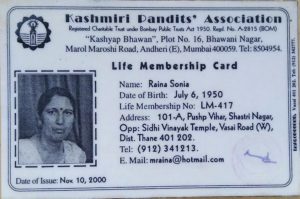
Biradari Directory
When I first compiled the Biradari Directory sometime in 1995, it was a laborious task. The old directory was grossly inadequate to rely upon. Several new KP families had moved into Mumbai since the last directory had been compiled, 7 or 8 years back. A lot many had changed their residences. There were no PCs and no soft copies then. I got an old type writer from one of my friends and started typing pages, partly from the old directory wherever residential addresses were deemed to be correct, and partly from the forms we had collected at Kashyap Bhawan over past 6 months. I remember having typed about 60 pages giving age, phone numbers, residential addresses and number of family members.
During a get-together at Kashyap Bhawan, I pasted the sheets on walls and asked people to check their names and see if the information given was correct. There were on spot corrections on the names and addresses. Many people had not come, so the work remained incomplete and I could not move ahead. Next I had to make telephone calls to the biradari people and ask for data on the phone itself. Connecting with people was not easy, and even if I was able to get through, you wouldn’t always get the right person to answer. I had to make repeat calls on my own, sometimes from my home, sometimes from the local PCO. It took me almost 6 more months to compile whatever data I could collect and get the directory printed.
Later I got my own PC and fed and saved the data in my PC. This enabled me to incorporate corrections almost on daily basis when communicated by the biradai members and from the records at Kashyap Bhawan. So Biradari Directory in my PC used to be always updated. If there was a wedding in the biradari, many people would ask for addresses and I used to gladly print a set and give them.
“My journey has been a long one, and because of my love for Kashmir and everything associated with Mäj Kasheer, I persevere to remain attached, to my people, my culture and to my language. It is my dream and endeavour, to help future generations to feel about our Motherland the way I do – with HOPE and a PRAYER….
Project Zaan
First half of the decade 2000 was Zaan Era. Project Zaan, a Project jointly organised by Kashmiri Pandits’ Association and Lalla Ded Educational & Welfare Trust, was started in 1998-99 and by the year 2001, it was in full bloom. Late Shri J.N.Kachroo, Ex-Principal, National High School, Srinagar was the motivating force behind the move. I learnt a lot from him and would never forget his contribution to the ZAAN.
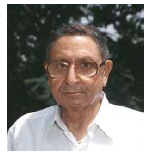
The yearly Quiz Programmes conducted at Kashyap Bhawan were the shows to witness and be proud of. Shri P.N.Wali named them Zaan Festivals. Mumbai Biradari showed big interest in the programmes and not only encouraged their young ones to participate but saw to it that they themselves were part of the celebrations. Winners in different age groups were awarded. As Convener of the Project, I had a big responsibility. KPA Presidents and their teams from time to time contributed a lot and organised everything well over the years.
Some memories on record


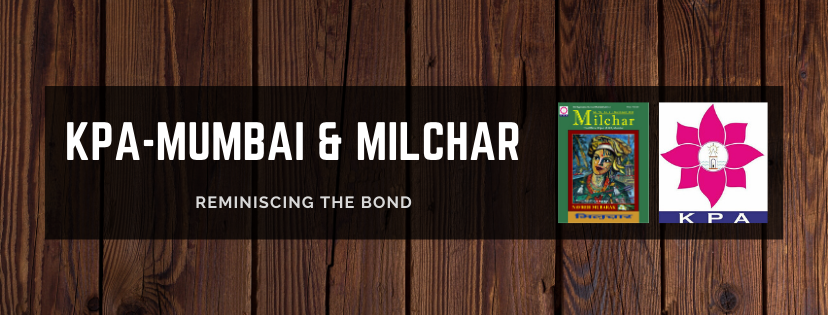



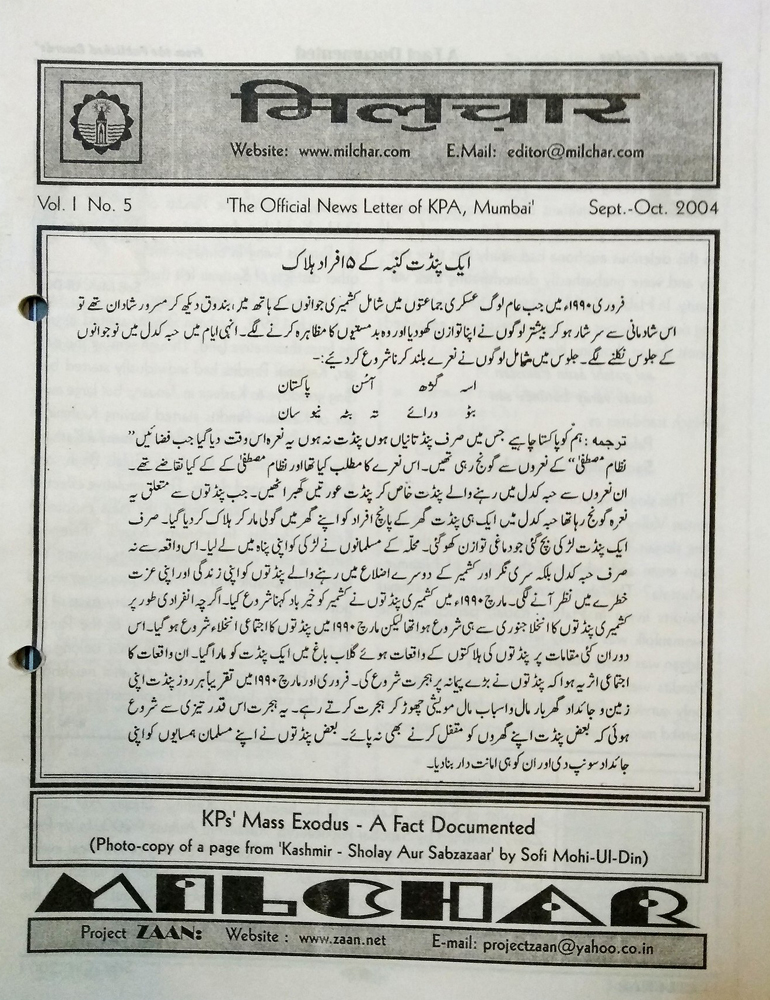
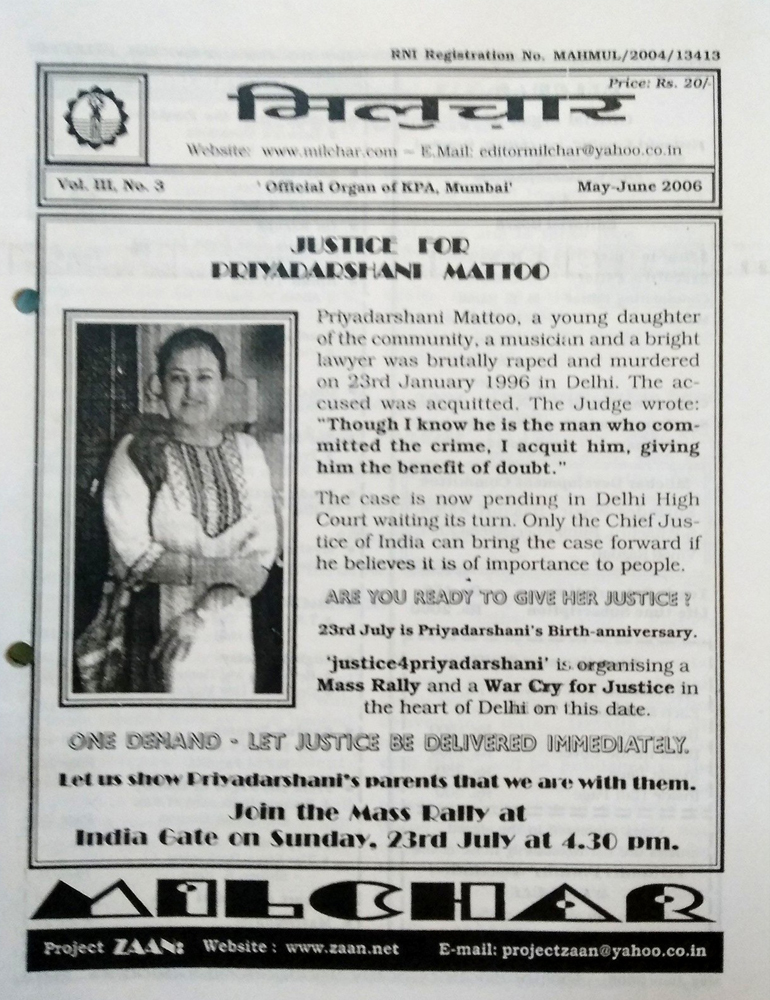
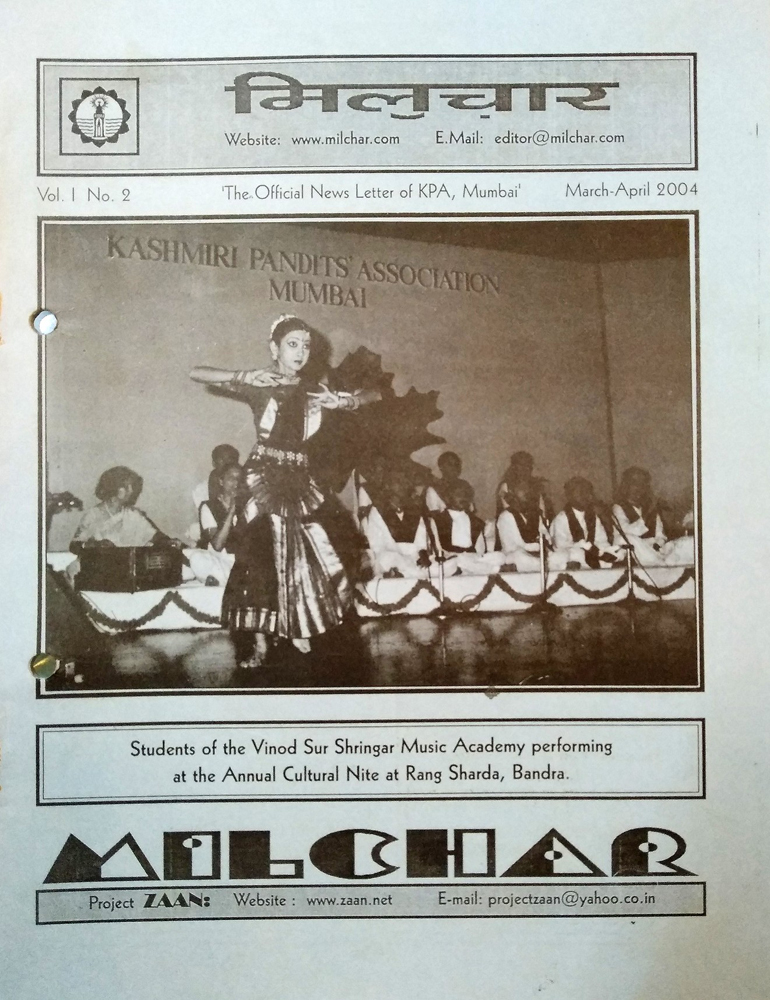
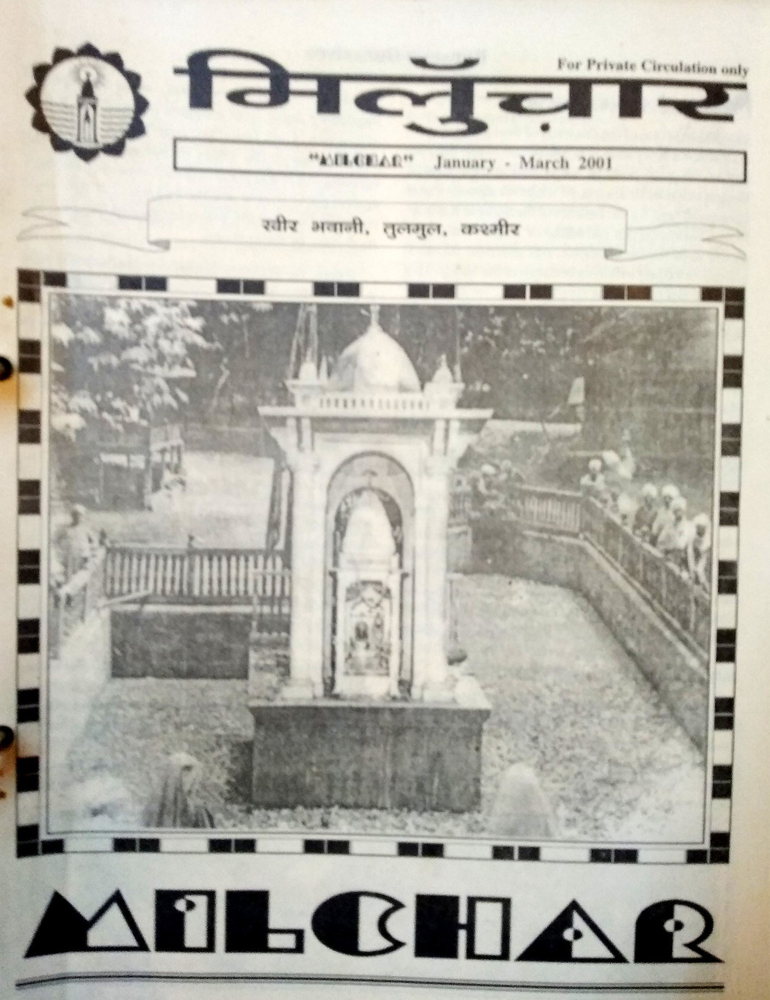

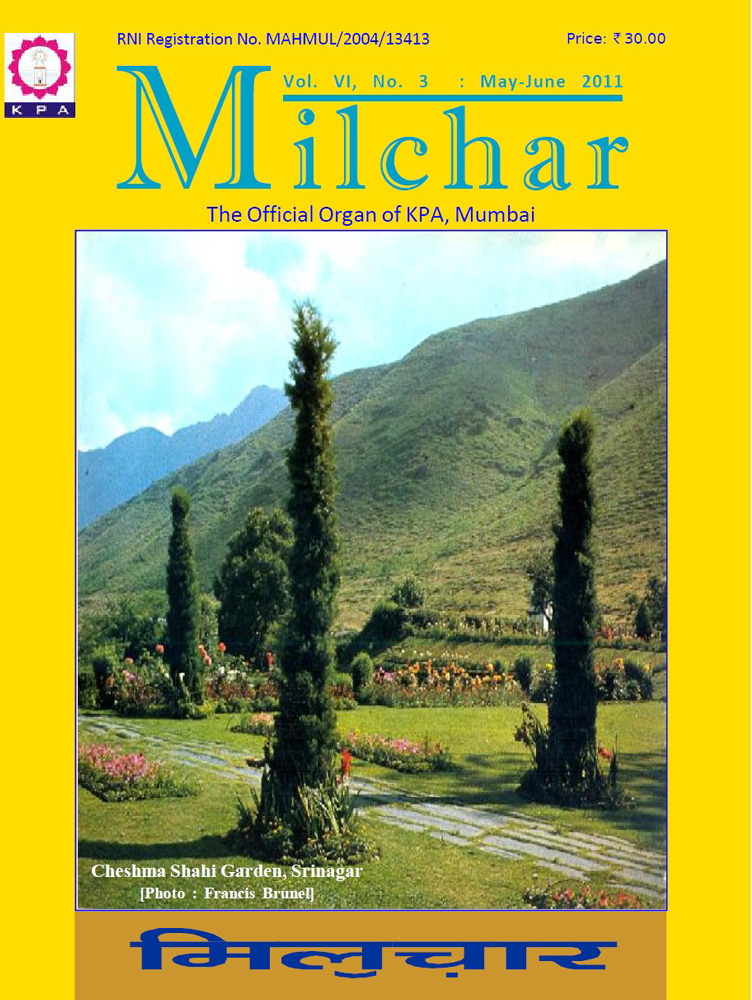
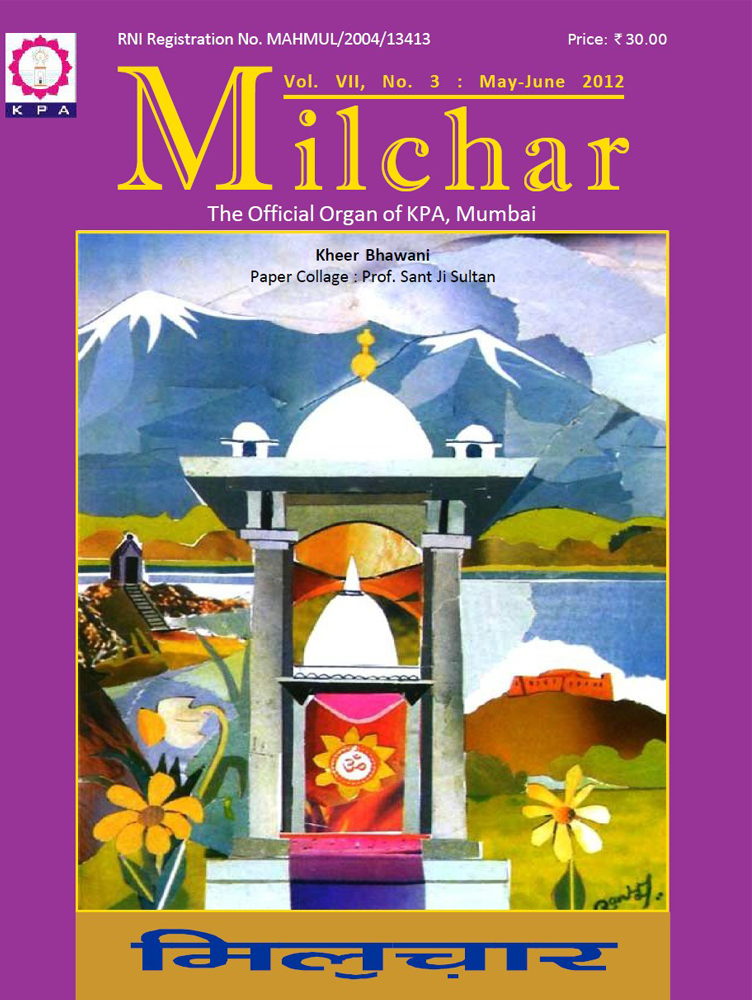
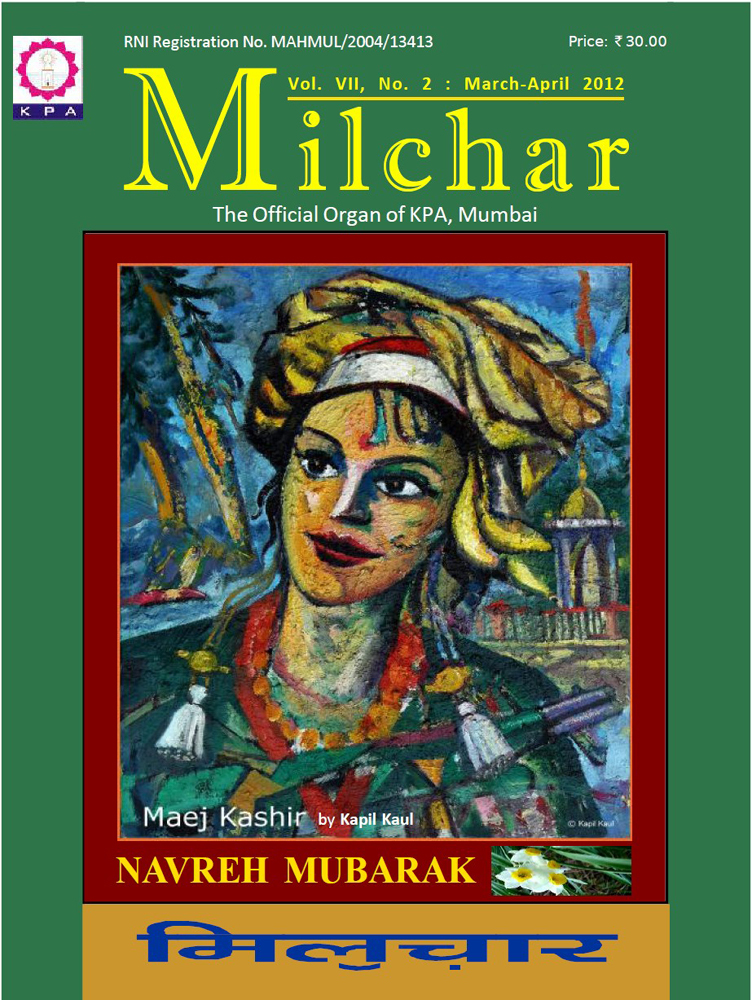

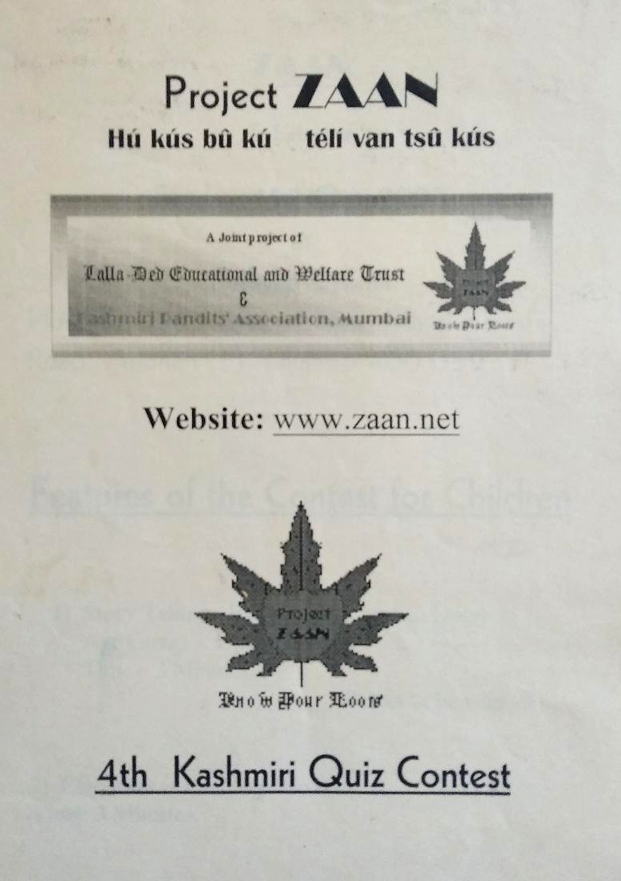
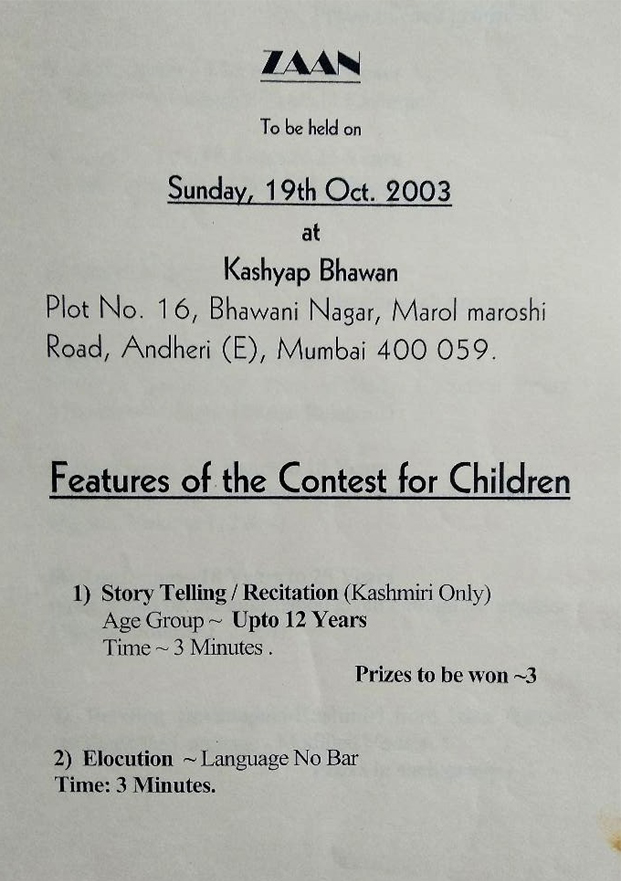

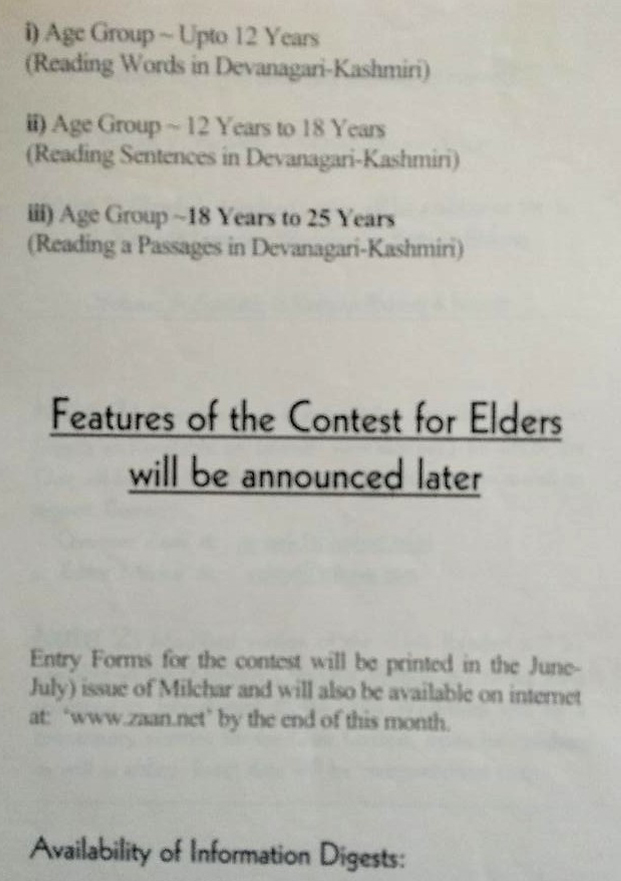
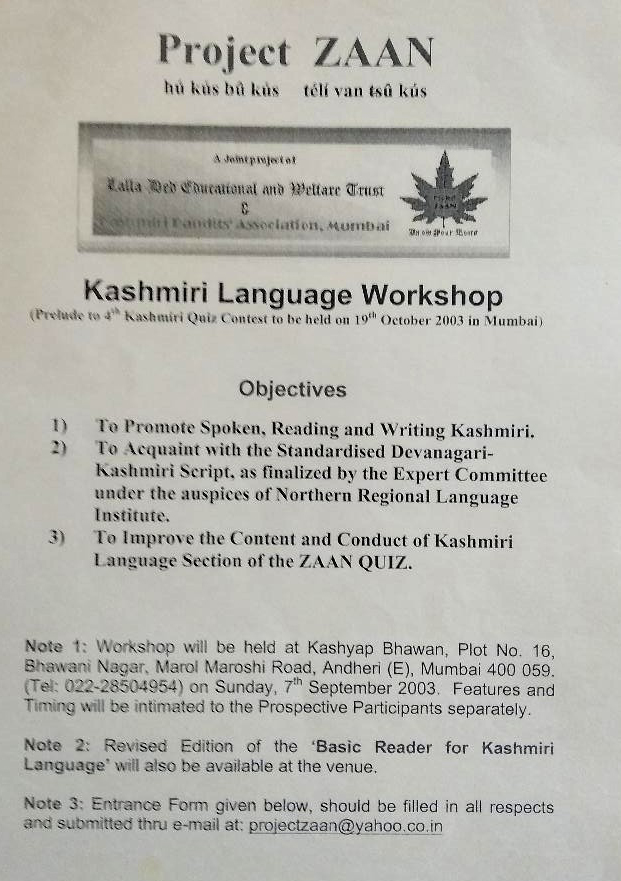
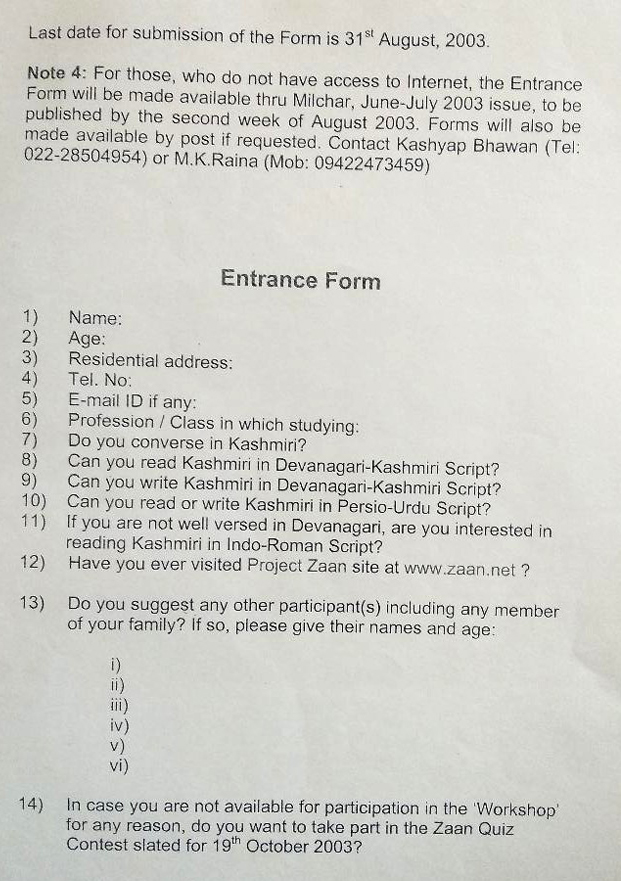
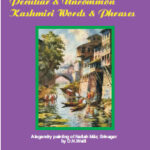
This information is a real treasure of our community. I was not really knowing so much about you and your association with KPA. Great to know.
Thanks for working tirelessly, your love for the community and preservation of its culture and language is second to none.